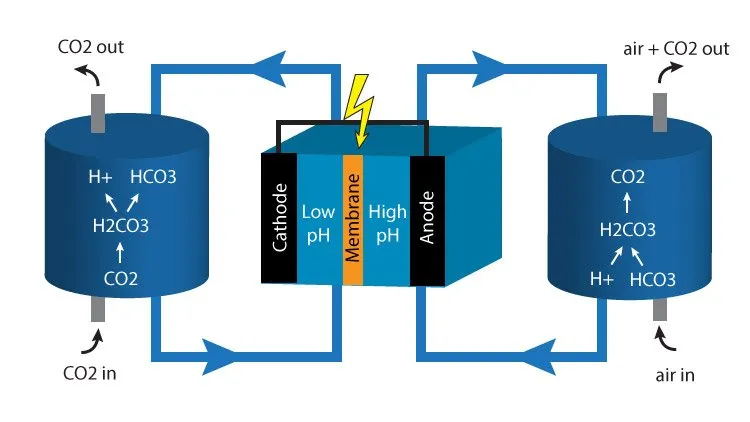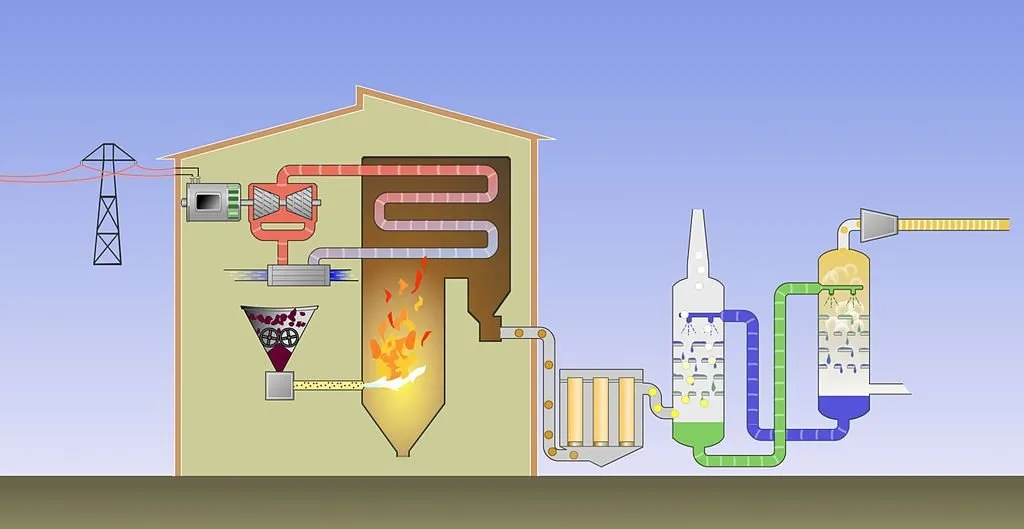A new remarkable type of rechargeable battery has been developed, called a flow cell. This flow cell can be recharged with a water-based solution containing dissolved carbon dioxide that was emitted from fossil fuel power plants.

How does this work? The concentration of CO2 differs between the emissions from fossil fuel power plants compared to the ambient air. Each can be made into a pH solution of varying level that is used to generate electricity. The flow cell can produce an average power density of 0.82 W/m2. Power density is the amount of power per unit for an area, or volume in other cases. This is an important consideration when space is a constraint. The amount of space required to produce power can determine the efficiency of a particular technology.
Previous flow cells are less efficient, with this version producing 200 times higher values. The other CO2 conversion technologies require expensive catalyst materials and very high temperatures.

CO2-based electrical generation
This new method of CO2 conversion to electricity is published in the recent Environmental Science & Technology Letters, and was developed by a team of scientists at Pennsylvania State University. Whether this is economically viable on a large scale has yet to be determined, but initial results are promising with improvements possible through further research and development.
There is a large difference in carbon dioxide concentrations between the gases found in air, and the gases found in gray-white smoke concentrations from burning fossil fuels. This difference is where the potential lies for us to tap into and use as a source for generating electricity.

CO2 emissions from combustion
The process requires to dissolve the CO2 gas and ambient air in separate containers using an aqueous solution. This is called sparging. The CO2-sparging process forms a bicarbonate ion solution with a lower pH of 7.7 compared to the ambient air-sparging solution with the pH of 9.4.
Each solution is then injected into one of two channels in a flow cell. This produces a pH gradient between the 7.7 and 9.4. The flow cell has electrodes on each side of the two channels, and a membrane that prevents mixing of the two solutions while still allowing ions to pass.
The pH difference between the two solutions is where the magic happens. As ions transfer from one side to the other they pass through the membrane which creates a voltage difference between the two electrodes and causes electrons to flow through a wire that's connecting the two electrodes together.
Once the ions pass from one side to the other, the solutions can be switched to use the opposite electrode. The charging mechanism is now reversed and electrons flow in the opposite direction. This recharging of the cell can be done for over 50 cycles of alternating the solutions.
The higher the pH difference, the higher the average power density. As mentioned before, this new flow cell technology has a greater power density than similar cells that convert carbon dioxide to electricity, but is still much lower than the power densities of fuel-cell systems like those that use combinations of CO2 and H2. The advantage this new flow cell are that it uses cheaper materials and can operate at room temperature. These factors alone make the new flow cell technology very attractive for practical applications.
This technology could eventually be coupled to existing power plants that combust fossil fuels. The exhaust emitted would need to be cooled and bubbled through the reservoir of water to then be pumped through various flow cell chambers to extract electricity from the different pH levels.
There is a lot of potential for this technology, and hopefully it will improve in performance, which is what the team of scientists will be working on doing next. Using CO2 emissions to generate electricity promotes greater energy sustainability.
References:
- Battery can be recharged with carbon dioxide
- Taeyoung Kim et al. "A pH-Gradient Flow Cell for Converting Waste CO2 into Electricity." Environmental Science & Technology Letters
Thank you for your time and attention! I appreciate the knowledge reaching more people. Take care. Peace.
If you appreciate and value the content, please consider:
Upvoting  , Sharing
, Sharing  or Reblogging
or Reblogging  below.
below.
Please also consider supporting me as a Steem Witness by voting for me at the bottom of the Witness page; or just click on the upvote button if I am in the top 50:


@krnel
2017-02-10, 12pm
